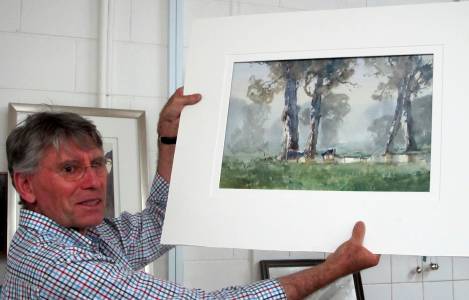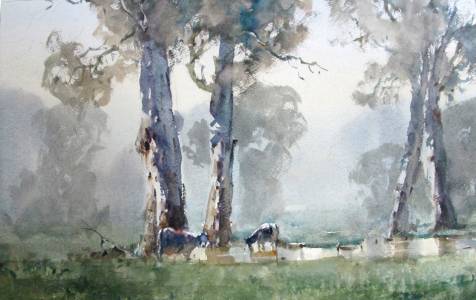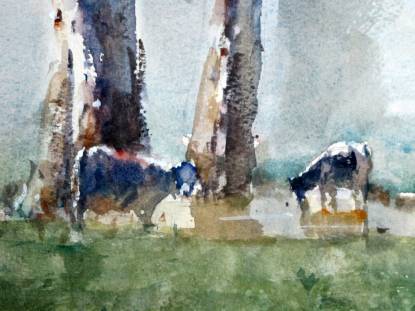Ron Muller Demonstration 15th March 2014
Watercolour Landscape
 You
want to paint a real watercolour? Like Ron Muller did? Look at the end
result. What do you see? Two big gum trees, two cows.
You
want to paint a real watercolour? Like Ron Muller did? Look at the end
result. What do you see? Two big gum trees, two cows.
Start there and you are dead in the water. We often say watercolour is the reverse of oils. Well it is, in many ways. And one way is in the procedure. You have to work backwards. Look closely. You want a misty scene with distant trees out of focus, a mere suggestion of trees. If you don't get that in early, you won't get it in at all. The water is a shine of clean paper. The cows have highlighted backs. These things come first, not in paint but in your memory. If you hit these bits with paint before the end you are gone. A watercolour has to be painted in your mind before you even start. Then it is quick. Twenty minutes should do it (plus twenty years of experience).
Run Muller was a cheerful humorous character. He was quite surprised by the size of the audience that were waiting for him quite early. He chatted to them. He got them on side somehow and everything he said brought a response. He often had the crowd laughing, although he only told one joke.
He loved our audio visual set-up. It was the first time we had used the lapel microphone and I think it proved its worth because all of his half-asides while painting with his back to the audience were clearly heard.
A little background showed him to have been an engineer, then in personnel with VicRoads before becoming an artist. He labelled himself as following the tradition of the English Romantics of the 1700s and 1800s. In all arts, poetry, painting etc. these artists were rebelling against the industrial revolution and returning to a love of nature. It was visible poetry. Light, atmosphere, mists, morning light. You can see it in today's painting. And the best medium to achieve that is watercolour.
He is much travelled with his art, having an affinity with Tuscany and France. In October he will be the artist-tutor with Alice's tour to China. (info@wizartescapades.com.au)
Ron prefers Saunders 300gsm. He wets and stretches it. A full-sized palette with mixing trays, but from that wide choice he only uses a limited number of colours in one painting. A blue, a red, a yellow. He said that the books advise against yellow ochre as it is opaque, but he uses it in diluted form. Any earth colour is opaque at full strength but with plenty of water is transparent. You should mix up plenty of your wash colours in big juicy pools because if you run out half way through a wash you will be lucky to get it right when you mix up more.
He said that people say to him, "You must feel so relaxed when you paint." No. It is a suspended state of frenzy!
Watercolour is a matter of putting the water and paint in place so it can do its own thing. Happy accidents. Timing comes into it. He did a bit of texture by striking a loaded brush against his stiff finger. He used a moist sponge to lift out the area of the main tree trunks. This first wash stage was quite faint as it would end up as the central foggy area.
Before beginning the closer areas he cleaned out his mixing dishes because he wanted to use stronger pigments. The two main trunks were backlit with the light coming from the left. The volumes of the cylinders were interesting. Where the light edge finishes the shading is darkest. The rest of the shaded part is reflected light, so less dark. Foliage is scumbled with a dry hard brush.
 Plan
to have your lightest light against your darkest dark. In this case it is
the highlight on the cow's back against the dark butt of the tree trunk.
This has been in your plan from the start and if you have stuffed it up by
painting over the cow's back you might just have to reach for the white
gouache. Ron says that you are allowed to do it. If you have to.
Plan
to have your lightest light against your darkest dark. In this case it is
the highlight on the cow's back against the dark butt of the tree trunk.
This has been in your plan from the start and if you have stuffed it up by
painting over the cow's back you might just have to reach for the white
gouache. Ron says that you are allowed to do it. If you have to.
Colin Browne, WAA Secretary
 How
to paint cows that look like cows.
How
to paint cows that look like cows.
Ron took the opportunity to teach us the basic shape of cows that would make them look realistic in our paintings.
Start with a shape like a matchbox. Then draw a line at 45° from the top right or left corner - this will be the neckline. Remember that a cow has a very heavy eyebrow that distinguishes it from a horse's head.